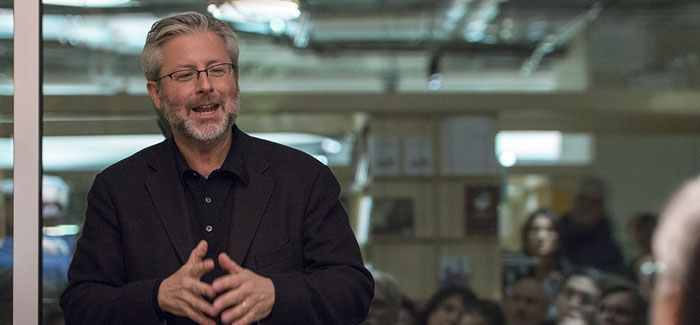
Shubin's tales of discovery show that humanity and the universe go way back. (Photography by Robert Kozloff)
Neil Shubin's new book traces the molecular connection between humanity and the cosmos.
The astronomer was at his wits’ end. Waves of celestial photographs were flooding into Edward Charles Pickering’s Harvard observatory, but his underlings couldn’t keep up. Working at the turn of the 20th century, the staff struggled to plot the heavens by hand. In a spate of frustration, Pickering declared that his maid could do better work—for a fraction of the cost.
He soon made good on his threat, adding his housekeeper, Williamina Fleming, to the all-male laboratory. She cataloged the images with such skill that he employed several more women, who became known as the “Harvard Computers.” Among them was Henrietta Leavitt, who developed a way to measure distances between stars and Earth based on star brightness. Adopted by astronomers around the globe, her cosmic ruler revealed a universe more expansive than anyone had imagined.
“That’s what this book is all about: narratives of discovery,” says Chicago paleontologist Neil Shubin, who chronicles stories like Leavitt’s in The Universe Within: Discovering the Common History of Rocks, Planets, and People (Pantheon Books, 2013). Driven by tales of exploration, it transports readers through the big bang to the present, tracing how ancient stellar happenings directly shaped who and what we are today—all in 190 pages.
“Having spent the better part of my working life staring at rocks on the ground,” Shubin begins his book, “I’ve gained a certain perspective on life and the universe.” It’s a perspective that mines the findings of unsung heroes in astronomy, physics, chemistry, and biology, as well as his own fossil-digging adventures around the globe.
Connecting the dots of human existence to its origins is familiar territory for Shubin, whose 2008 bestseller, Your Inner Fish (Pantheon), drew evolutionary links between our anatomical structure and those of fish, worms, and algae. Now he’s branched out to the cosmos, mapping how the molecules that make up our bodies as well as the planet have their origins in the birth of the universe itself.
“Rocks and bodies are kinds of time capsules that carry the signature of great events that shaped them,” Shubin writes. Roughly three minutes after the big bang, for example, the first tiny hydrogen atom emerged; today the element makes up 90 percent of all matter, including the bulk of the human body. Other, heavier elements inside us such as cobalt and cesium come from exploding supernovae that scatter atoms from dead stars across the galaxies. “The atoms that reach our planet,” he reveals to the reader, “have been the denizens of innumerable other suns.”
Our concept of time is another link. According to current theory, when an asteroid collided with young Earth more than 4.5 billion years ago, the debris began to orbit the planet and eventually became the moon. Meanwhile, the jolt left Earth with a 23.5-degree tilt in its axis of rotation. Ever since, Shubin writes, “the two bodies have been locked in an orbital dance” that dictates the length of our days, months, and seasons.
These clocks run deep. Researchers have found that even subjects living in subterranean caves deprived of all natural light and time cues still follow a steady 24-hour cycle of rest and activity, dictated by the waltz of Earth and its moon.
Any scientist will be well acquainted with these plotlines, but others may find them surprising. “There’s a huge disconnect between what my colleagues and I take for granted and what the general public understands about science,” Shubin explains. “We compare fish to people all the time, but when I would go to anyone outside of science, including my family, they would say ‘What do you mean my ear bones relate to the jawbones of reptiles? That’s the strangest thing I’ve ever heard.’”
Shubin relished the opportunity to make our vast cosmic connections accessible to a broader audience. “If I had said, ‘Here’s the history of the universe in your body in 800 pages’ and shoved it across the table, I would lose them,” he says. “I wanted it to be profound but light as a feather.”
